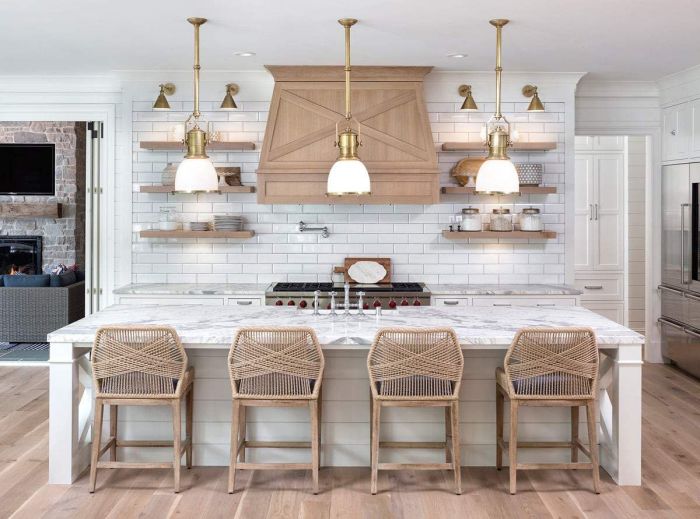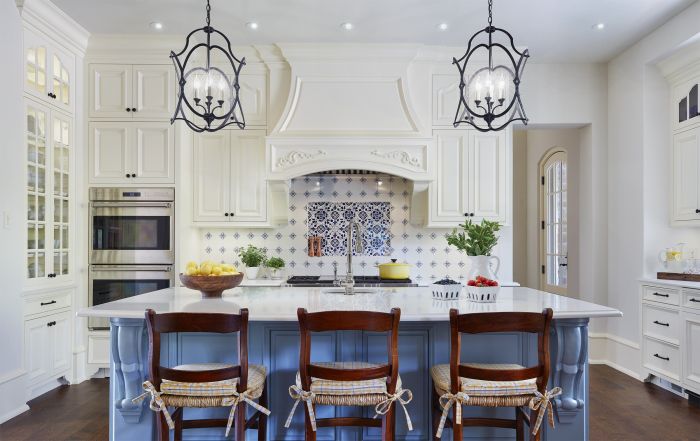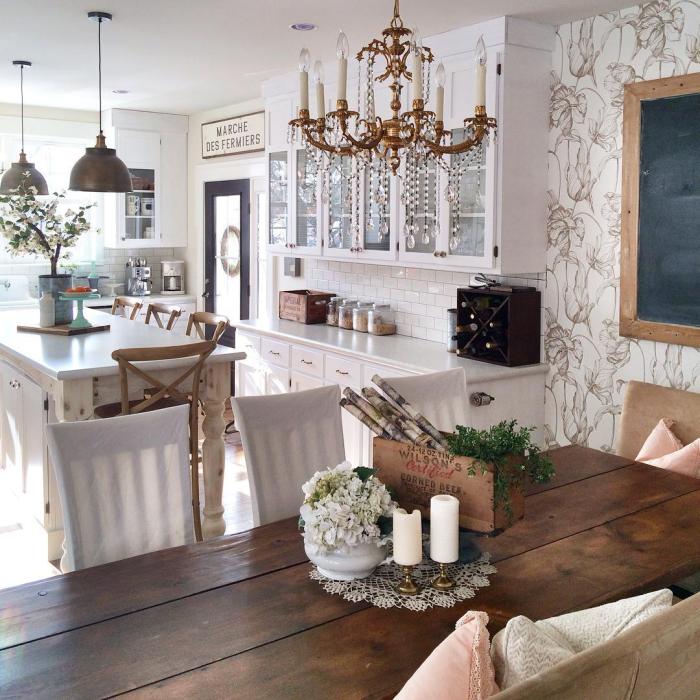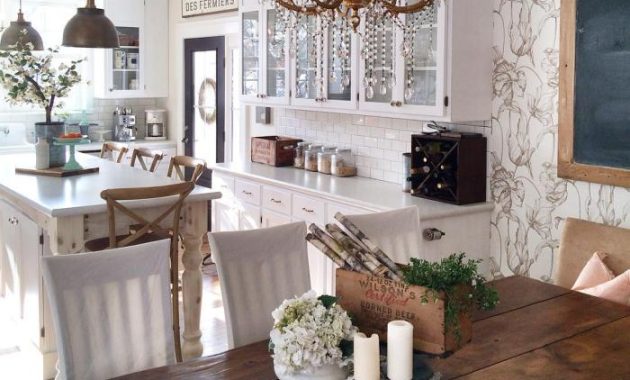Defining “Country French Kitchen Decor”
Country French kitchen decor is a design aesthetic that blends the rustic charm of rural French life with the warmth and functionality of a well-loved kitchen. It evokes a sense of timeless elegance, characterized by its use of natural materials, handcrafted details, and a palette of soft, muted colors. This style transcends mere aesthetics; it embodies a narrative of history, tradition, and a connection to the land.The historical influences shaping this style are deeply rooted in the diverse regional cuisines and architectural styles of France.
The evolution of the style is traceable to the post-World War II era, when a romanticized vision of French rural life gained popularity, particularly in America. This nostalgic ideal, often depicted in films and literature, fueled a desire to recreate the atmosphere of charming French country kitchens in homes across the globe. Elements such as antique furniture, exposed beams, and vintage tableware became increasingly sought-after, shaping the core characteristics of the style.
The design evolved further, incorporating modern conveniences while retaining its core aesthetic principles. The incorporation of modern appliances alongside antique elements demonstrates the style’s adaptability and ongoing evolution.
Historical Influences and Evolution of Country French Kitchen Design
The origins of Country French kitchen design are multifaceted. The style draws inspiration from several regions of France, each with its unique culinary traditions and architectural styles. For instance, the Provence region, known for its sun-drenched landscapes and lavender fields, contributes a lighter, brighter aesthetic with its signature pastel colors and wrought iron accents. Normandy, with its rich history of dairy farming and apple orchards, influences the style through the use of darker wood tones and more substantial furniture.
The evolution of this design aesthetic is closely tied to changing social and economic conditions in France and the global spread of French culture through media and tourism. The rise of mass-produced furniture and appliances in the mid-20th century allowed for wider accessibility of elements associated with the style, leading to its broader adoption.
Comparison with Similar Styles: Provence and Farmhouse
While Country French, Provence, and Farmhouse styles share certain similarities, distinct characteristics differentiate them. Provence style, often considered a subset of Country French, emphasizes lighter colors, brighter spaces, and a strong connection to the Mediterranean landscape. Think of sun-bleached woods, pale blues and yellows, and the incorporation of terracotta. Farmhouse style, while also rustic, tends to be more utilitarian and less ornate.
It often features more pronounced signs of wear and tear, celebrating the patina of age and functionality. Country French sits between these two, incorporating elements of both but maintaining a more refined and elegant overall aesthetic. The key difference lies in the level of ornamentation and the specific color palettes used. Country French tends to use more decorative elements and a softer, more muted color palette than Farmhouse, while maintaining a warmer and more rustic feel than the typically brighter Provence style.
The use of specific materials like limestone, antique hardware, and specific types of wood also further distinguish these styles.
Color Palettes and Materials

The aesthetic of a Country French kitchen hinges on a carefully curated balance of colors and materials. The chosen palette evokes the feeling of sun-drenched Provençal landscapes or the rustic charm of a Normandy farmhouse, while the materials employed reflect a commitment to durability and natural beauty, echoing the region’s rich history and craftsmanship. This combination creates a space that is both inviting and sophisticated.
The color palettes employed are typically characterized by their soft, muted tones, often inspired by the natural surroundings of the French countryside. Materials selection prioritizes those with a history of use in traditional French construction and design, emphasizing the enduring qualities of natural resources.
Country French Kitchen Color Palettes
Several color schemes consistently define the Country French aesthetic. These palettes, often featuring variations in hue and saturation, create a cohesive and harmonious atmosphere. The choice of a specific palette can subtly alter the overall mood of the kitchen, from a bright and airy feel to a warm and cozy ambiance. The following table provides examples of these common color palettes.
| Palette Name | Primary Colors | Accent Colors | Overall Mood |
|---|---|---|---|
| Provençal Sunshine | Warm Cream, Soft Yellow, Pale Green | Terracotta, Olive Green, Dusty Rose | Bright, Airy, Inviting |
| Normandy Charm | Off-White, Light Gray, Soft Blue | Taupe, Slate Gray, Deep Blue | Serene, Calm, Rustic |
| Tuscan Romance | Warm Beige, Light Brown, Soft Peach | Terracotta, Burnt Orange, Deep Red | Warm, Cozy, Romantic |
| Loire Valley Elegance | Ivory, Pale Gray, Soft Lavender | Silver, Light Green, Pale Pink | Sophisticated, Elegant, Refined |
Materials Selection in Country French Kitchens
The choice of materials significantly contributes to the authentic character of a Country French kitchen. These materials are not only visually appealing but also durable and capable of withstanding daily use, reflecting the practicality inherent in traditional French design. The selection often emphasizes natural materials, evoking a sense of timelessness and connection to the land.
Flooring commonly utilizes materials like terracotta tiles, wide-plank reclaimed wood (often oak or pine), or stone, reflecting the natural earth tones of the French countryside. These materials often display natural variations in color and texture, adding to their rustic charm. For example, reclaimed wood flooring, often showing signs of wear and age, adds a unique character to the space, telling a silent story of the material’s past life.
Terracotta tiles, with their inherent variations in shade and texture, bring warmth and a touch of the Mediterranean to the kitchen.
Cabinetry frequently features painted wood, often in a distressed finish to create a sense of age and patina. The wood itself might be solid oak, pine, or even chestnut, chosen for its durability and natural beauty. The paint finish, often a chalk paint or a similar distressed effect, allows the wood grain to subtly show through, adding depth and character.
This technique creates a visually rich surface that speaks to the passage of time and traditional craftsmanship.
Countertops are often made from natural stone such as limestone, granite, or marble. These materials provide a durable and elegant surface, reflecting the richness and natural beauty of the French countryside. The veining and variations in color inherent in natural stone add a unique character to the countertop, further enhancing the kitchen’s rustic appeal. For example, limestone, with its subtle veining and soft tones, offers a classic and elegant look, while granite provides a more robust and durable option.
Paint Finishes for Achieving the Country French Look
Achieving the authentic look of a Country French kitchen often involves careful consideration of paint finishes. The chosen finish significantly impacts the overall aesthetic, contributing to the sense of age, texture, and character. Distressed and chalk paint finishes are particularly popular for their ability to evoke a sense of history and handcrafted charm.
Distressed finishes, often achieved through techniques like dry brushing or sanding, create a worn and aged appearance, giving the impression of years of use and character. This finish subtly reveals the underlying wood grain, adding depth and visual interest. The effect suggests a history of use and adds to the kitchen’s rustic charm.
Chalk paint, known for its matte finish and ability to adhere well to various surfaces, is another popular choice. Its slightly imperfect application allows the wood grain to show through, contributing to the rustic and weathered look associated with Country French design. The matte finish avoids the glossiness that would clash with the rustic aesthetic.
Furniture and Fixtures

The heart of a Country French kitchen lies in its furniture and fixtures. These elements, carefully chosen and arranged, contribute significantly to the overall aesthetic, transforming the space into a charming and functional hub. The selection process involves considering both practicality and the stylistic integrity of the design, ensuring a harmonious blend of form and function. Careful consideration of materials, finishes, and age will contribute to the overall effect.The strategic placement of furniture and the careful selection of lighting fixtures are crucial for achieving the desired ambiance.
The layout should promote both efficient workflow and a visually appealing space, enhancing the feeling of warmth and rustic elegance characteristic of the style. A well-lit kitchen, with lighting that complements the overall aesthetic, is essential for both functionality and visual appeal.
Kitchen Furniture Layout
A typical Country French kitchen layout might feature a large, rustic farmhouse table as the centerpiece. This table, ideally made of solid wood like oak or pine, with a slightly distressed finish, serves as a gathering point and a practical work surface. Surrounding the table, a set of antique-style chairs, perhaps with cane seats and slightly curved legs, completes the ensemble.
A built-in hutch or dresser, often featuring glass-fronted cabinets to display fine china or decorative items, adds both storage and visual interest. A baker’s rack or a freestanding shelving unit provides additional storage and display space for cookware and other kitchen essentials. Consider placing a charming, possibly slightly worn, kitchen island for extra workspace and seating.
Lighting Fixtures
Lighting plays a crucial role in setting the mood and highlighting the architectural details of a Country French kitchen. Wrought iron chandeliers, with their delicate curves and ornate detailing, are a classic choice, casting a warm, ambient glow. Alternatively, pendant lights with simple, yet elegant designs, made from materials such as wrought iron or aged brass, can be hung above the island or the farmhouse table.
Wall sconces, preferably in a similar style to the chandeliers or pendant lights, can provide additional illumination and enhance the overall aesthetic. Consider incorporating softer lighting options like table lamps for a cozy, intimate atmosphere. The use of natural light, where possible, should be maximized to enhance the overall brightness and airy feeling.
The Role of Antique and Vintage Elements
The incorporation of antique or vintage elements is paramount in achieving an authentic Country French kitchen aesthetic. These elements add character, history, and a sense of warmth that is difficult to replicate with modern pieces. A vintage enamelware sink, with its charming imperfections and patina, adds a touch of rustic charm. Similarly, repurposed wooden beams or salvaged architectural elements can be incorporated into the design to add visual interest and historical depth.
Antique or vintage tableware, displayed on open shelving or within the hutch, provides visual interest and reinforces the overall theme. The subtle imperfections and signs of age present in these pieces add to their unique character and contribute significantly to the authentic feel. Even small details, like antique doorknobs or vintage cabinet hardware, can make a significant difference in creating a cohesive and historically inspired space.
Illustrative Examples: Country French Kitchen Decor
The following examples showcase the versatility of Country French kitchen design, demonstrating how variations in light, materials, and stylistic choices can create distinct atmospheres while maintaining the core aesthetic. These examples are not exhaustive, but they illustrate the breadth of possibilities within this design style.
A Sun-Drenched Country French Kitchen
Imagine a kitchen bathed in the warm glow of natural light, streaming through expansive windows overlooking a verdant garden. The walls are painted in a soft, creamy yellow, reminiscent of sun-bleached stone. This choice, informed by the principles of biophilic design which emphasizes the connection between humans and nature, promotes a sense of calm and well-being. The flooring is composed of wide, honey-colored oak planks, their natural variations adding character and texture.
The cabinetry is painted in a slightly darker shade of yellow, creating a subtle contrast. Distressed, antique-white wooden chairs surround a farmhouse-style table made of reclaimed wood, exhibiting the natural beauty of the material’s imperfections. Open shelving displays a collection of vintage enamelware and ceramic cookware, adding pops of color and visual interest. A large, rustic-chic pendant light fixture hangs above the island, providing focused illumination while maintaining the overall airy ambiance.
The overall effect is one of cheerful warmth and rustic elegance. The abundant natural light significantly impacts the perceived spaciousness, a key element of this design. Scientific studies have shown that natural light improves mood and productivity, making this kitchen a delightful and functional space.
A Rustic Country French Kitchen
In contrast to the bright and airy example, this kitchen embraces a darker, more rustic aesthetic. The walls are clad in dark, reclaimed wood paneling, showcasing the rich textures and natural variations of the aged timber. This choice is informed by the historical use of wood in traditional French architecture, creating a sense of timelessness and authenticity. The flooring is composed of dark terracotta tiles, their earthy tones grounding the space.
The cabinetry is made of dark oak, displaying a rich, deep grain. Black iron hardware adds a touch of industrial chic, counterpointing the warmth of the wood. Antique brass sconces provide soft, ambient lighting, highlighting the deep tones of the room. The island is topped with a thick slab of honed granite, its cool grey tones providing a textural contrast to the warmth of the wood.
A large, antique copper pot hangs from a sturdy wooden beam, adding a touch of rustic charm. The overall atmosphere is one of cozy intimacy and old-world charm. The subdued lighting, influenced by the traditional use of candlelight and fireplaces, contributes to a feeling of warmth and seclusion.
A Modern Country French Kitchen
This design blends traditional French country elements with contemporary lines and materials. Clean-lined cabinetry in a crisp white finish provides a sense of airy modernity. However, the cabinetry features subtle details such as fluted panels and delicate molding, echoing traditional French design principles. The countertops are made of sleek, white quartz, offering durability and a contemporary aesthetic. The backsplash features a mix of subway tiles and artisan-made ceramic tiles in muted blues and greens, creating a visually interesting focal point while maintaining a sense of harmony.
Stainless steel appliances seamlessly integrate into the design, adding a touch of modern functionality. Modern pendant lighting in a simple, geometric design provides focused illumination. A large, farmhouse-style sink in a matte black finish adds a touch of industrial chic. The overall effect is a sophisticated blend of old and new, creating a space that is both stylish and functional.
The integration of modern materials and technology exemplifies a contemporary approach to traditional design, showcasing a harmonious blend of styles.
Country French kitchen decor evokes a sense of rustic charm, often featuring warm, earthy tones and vintage-inspired elements. To enhance this aesthetic without overwhelming the space, consider incorporating simple yet impactful wall decor; for inspiration, check out these simple kitchen wall decor ideas that can easily complement a French country style. A few carefully chosen pieces can beautifully accentuate the overall ambiance of your charming country French kitchen.
Regional Variations

The stylistic diversity within French country kitchen design is not merely aesthetic; it reflects the unique terroir and cultural heritage of each region. Geological factors, agricultural practices, and even historical events have shaped the materials, colors, and decorative elements found in kitchens across France. Examining these regional variations reveals a rich tapestry of design influences, demonstrating the deep connection between culinary culture and the built environment.Regional variations in French country kitchen design are primarily dictated by the readily available local materials and the region’s distinct architectural style.
Proximity to specific resources influences the dominant materials used in construction and furnishings, while the overall architectural aesthetic often dictates the color palette and decorative motifs. This interplay between environment and design results in kitchens that are both functional and deeply rooted in their geographical context.
Normandy vs. Provence: A Material Contrast
Normandy, with its rich coastal plains and forests, showcases kitchens characterized by the use of light oak and beech woods. These materials, readily accessible locally, are often employed in cabinetry, flooring, and even ceiling beams. The color palette tends towards softer, muted tones, reflecting the region’s often overcast skies – think creamy whites, pale yellows, and soft greys. Decorative elements frequently incorporate nautical motifs, reflecting Normandy’s maritime heritage.
In contrast, Provençal kitchens, influenced by the region’s sun-drenched landscapes and abundant limestone, utilize warmer materials and colors. Darker woods, such as chestnut, are common, along with the extensive use of natural stone, particularly in countertops and flooring. The color palette leans towards sun-kissed yellows, warm terracotta reds, and deep blues, mirroring the vibrant colors of the Provençal countryside.
Decorative elements often incorporate lavender motifs, reflecting the region’s renowned lavender fields.
Material Choices Reflecting Regional Resources, Country french kitchen decor
The choice of materials is fundamentally tied to regional availability. Normandy’s abundance of timber translates into kitchens dominated by wooden cabinetry, flooring, and beams, often left in a natural or lightly bleached finish. The use of stone is less prevalent than in Provence, where limestone quarries provide ample material for countertops, flooring, and even walls. This contrast highlights the influence of geological resources on kitchen design.
In contrast, the clay-rich soils of Provence lend themselves to the creation of terracotta tiles, which are frequently used for flooring and backsplashes, adding warmth and a distinctly Provençal character to the kitchen space. These regional variations in material usage directly reflect the environmental context and the readily available resources of each region.
Color Palettes and Decorative Elements: A Reflection of Regional Identity
The color palettes used in country French kitchens often mirror the surrounding landscape. The softer, more muted tones of Normandy reflect the region’s often overcast skies and verdant landscapes. The use of pale blues and greens, reminiscent of the sea and the countryside, is common. In contrast, the vibrant colors of Provence, reflecting the intense sunlight and abundant flora, are evident in the use of warm yellows, terracotta reds, and deep blues.
These colors are often found in painted cabinetry, wall treatments, and decorative textiles. Furthermore, decorative elements are often regionally specific. Nautical motifs, such as anchors and rope details, are common in Normandy, while lavender motifs and toile de Jouy fabrics are prevalent in Provence. These regional variations in color palettes and decorative elements clearly illustrate the deep connection between the kitchen’s aesthetic and the region’s cultural identity.
Top FAQs
How much does it cost to design a Country French kitchen?
Costs vary wildly depending on the size of your kitchen, the materials you choose, and whether you DIY or hire professionals. Expect a range from budget-friendly to quite luxurious.
Where can I find antique pieces for my Country French kitchen?
Antique shops, flea markets, online marketplaces (like Etsy), and even antique auctions are great places to hunt for unique finds. Be patient – the perfect piece will come along!
Can I blend modern elements with Country French style?
Absolutely! A modern twist can add a fresh, updated feel. Think sleek stainless steel appliances alongside antique cabinetry, for instance.
What are some common mistakes to avoid?
Overdoing it with too many patterns or colors is a common pitfall. Maintain a balanced and cohesive look to avoid a cluttered feel.

